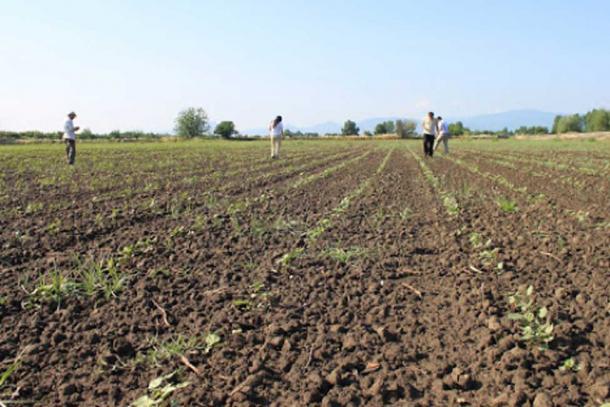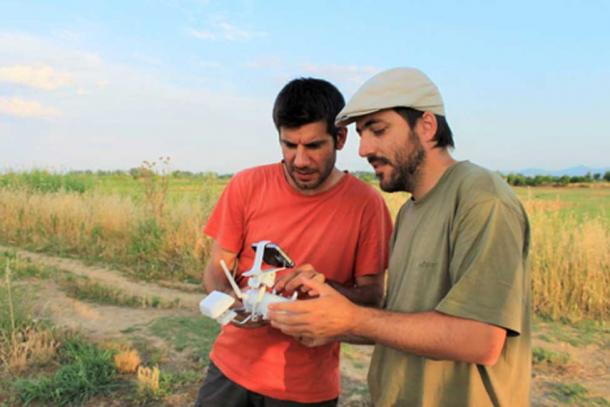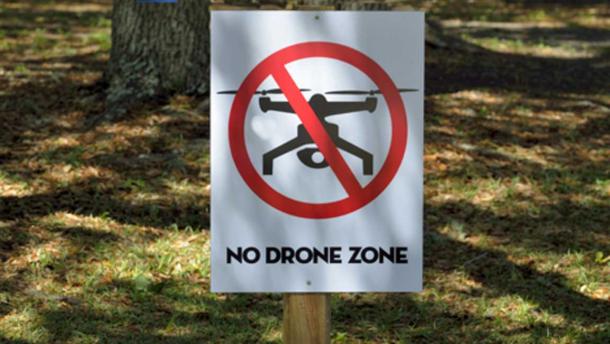what do historic archaeologists have access to that sets them apart from other archaeologists?
Fieldwalking and Aerial Photographs
About archaeologists take had the pleasure of fieldwalking, aka 'pedestrian surveying' at some bespeak in their career. This is a survey technique employed by a grouping of archaeologists, or archæology students, who head out equally a team to walk across a large area of open up state they think may exist of archaeological interest. Usually the land of choice for this survey method is a recently plowed farmer's field , all-time if it's rained not too long ago.
The team spreads out in a methodical filigree-like manner, ordinarily parallel lines of a set distance apart, to see if they tin find any archaeological material that has been pushed to the surface – oftentimes that ways pottery fragments ( potsherds). Flint tools and other artifacts are likewise constitute sometimes with this method.

A team conducting a pedestrian archaeological survey aka "fieldwalking." (Anna Karligioti)
It'south notoriously long, hard, and sometimes tedious work, but fieldwalking has been a traditional practice since archaeology's early days as a discipline.
Simplifying the Detection of Potsherds and More!
Only new enquiry published in the Journal of Archaeological Science suggests there may be a better way.
Dr. Hector A. Orengo of the Catalan Institute of Classical Archaeology and Dr. Arnau Garcia-Molsosa of the McDonald Institute for Archaeological Inquiry at the Academy of Cambridge recall they may have the reply to the fieldwalking headache, or at least the beginning of a solution. A University of Cambridge press release states that the researchers aim "to alleviate labor-intensive archaeological field surveying past combining machine learning and high-resolution drone imagery."

Dr. Arnau Garcia-Molsosa and Dr. Hector A. Orengo watching the drone. (Anna Karligioti)
What they accept tested out is a new archaeological survey method – flying a pre-programmed drone over the area of interest and taking overlapping pictures. The images are then joined together to create what they call "a single very large high-resolution image."
You may be wondering why they started with potsherds – which are substantially disrepair up pieces of ceramic. Orengo provides this explanation:
"The distribution of potsherds is a good indication of the intensity of human occupation and the location of archaeological sites, but traditional survey methods tin can be quite costly and labor-intensive. Some of our projects in the Mediterranean involved the collection and recording of big quantities of pottery, but a single relatively small site could accept our 6-people team three days to tape! Automated survey was something nosotros used to fantasize most while in the field."
Garcia-Molsosa continues the idea:
"Under ideal circumstances this method is more accurate and faster than standard survey approaches. This is a complementary method to traditional pedestrian survey and has the potential to transform the way landscape survey is done. The automated recording of surface fabric civilization has enormous possibilities to contribute to a wide array of projects working on academic research and heritage management. We promise that this technique tin be employed, adapted and improved by other teams and so we can understand better its potential awarding."
This new method may be an interesting alternative to three days of walking across open fields, which is certainly time-consuming and oftentimes a costly matter (people are sometimes paid for the task and at to the lowest degree they need food and shelter if they'll exist trekking the fields for a few days).

'The Lonesome Archaeologist' Fieldwalking in 2014. (Paul Wood/ CC Past SA 2.0 )
Possibilities and Limitations
However, it is non perfect and the researchers too realize that there are some limitations to the method as it stands right now.
For example, they plant the algorithm may provide false positives if the settings are more stringent and incorrectly advise that modern brick fragments are pottery. Or, conversely, less strict settings could hateful the algorithm misses some of the potsherds. Thankfully, this blazon of technical issue could probably exist ironed out in the time to come. But until that happens, there is the question of how much fourth dimension may really be saved – people still need to check the algorithms work and perchance become out and find and then pick up the potsherds by hand.

Upper image showing a drone-caused image of the ground. Lower epitome showing the sherds detected past the motorcar learning algorithm. (Arnau Garcia-Molsosa and Hector A. Orengo)
A much larger limitation is that the method is currently nonetheless restricted to the same conditions equally traditional fieldwalking – flat, plowed soils that are vegetation-free. However, the researchers say they "are now working on developing drone technologies that can better arrange to irregular terrain, avoid copse, and other barriers and extend the drone flight times that are currently available." Now that could be a more useful surveying tool, merely still means restrictions to state that is relatively constitute-complimentary.
Orengo and Garcia-Molsosa state they are also working on creating "new artificial intelligence-based methods to better the algorithm detection ratio and extend its identification abilities to other types of material culture, such as lithics and metal." This would be a nice add-on to the current focus on potsherds.
Some other cause of concern is how feasible this method will exist in the future. Drones are still relatively new technology, but legislation is changing and restrictions on drone usage are emerging. If too much ruddy tape is added, information technology may be easier for archaeologists to merely stick with the old ways than await for permission to use their aerial tools.

Drones may not exist permitted in some areas of archaeological interest. ( CC0)
But in the finish the researchers still see their drone-machine learning fix as a complementary method to the skilful old-fashioned ways of or archaeological forebears – fieldwalking. Information technology seems that even while archaeology is taking technological steps into the future with drones and scans, there is still 1 foot in the past and keeping some (useful) traditions alive.
Tiptop Image:
mackellarwileved78.blogspot.com
Source: https://dronelife.com/2019/09/30/archaeologists-are-using-drones-to-find-good-places-to-dig-the-search-for-potsherds/
0 Response to "what do historic archaeologists have access to that sets them apart from other archaeologists?"
Post a Comment